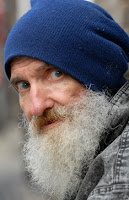About four years ago, I met Jesus on a park bench. His face was grizzly, his beard was dirty, and our conversation was awkward. But before I get into that, let me back up a little.
During my college years I became enchanted by Jesus. In particular, I was astounded at how comfortable he was with poor people, ugly people, sick people, and people on the margins.
He just seemed to interact with them differently than anyone else I had ever known. And he looked at them differently, too. His gaze focused on their dignity rather than on their poverty.
I found all of this intriguing and soon wondered how I could see people the same way. I wanted to gaze on the people society considered worthless, lazy, and burdensome and instead be fascinated by their value.
It should come as no surprise that around the same time I also became captivated by Mother Teresa. I marveled at her otherworldly compassion and wondered how I could imitate her, too.
 Many of Mother’s admirers would ask her, “How can you keep serving the poor, the sick, and the dying with such vigor? What’s the secret? How do you do it?”
Many of Mother’s admirers would ask her, “How can you keep serving the poor, the sick, and the dying with such vigor? What’s the secret? How do you do it?”
Mother’s answer was surprising and profound. “Whenever I meet someone in need,” she said, “it’s really Jesus in his most distressing disguise.”
Jesus in the child abandoned by the road.
Jesus in the beggar hoping for a meal.
Jesus in the leper whose limbs have turned to dust.
“It’s him I help—him alone.”
When pushed further, she referenced Matthew 25 where Jesus confirms her response:
“Then the righteous will answer him and say, ‘Lord, when did we see you hungry and feed you, or thirsty and give you drink? When did we see you a stranger and welcome you, or naked and clothe you? When did we see you ill or in prison, and visit you?’
And the king will say to them in reply, ‘Amen, I say to you, whatever you did for one of these least brothers of mine, you did for me.'”
Which takes us back to the park bench. One muggy Tallahassee day, I was resting at a picnic table when suddenly a strange, disheveled man plopped down right across from me. Without exchanging hello’s he stared deep into my eyes and boldly shouted, “I am Jesus Christ! Your Lord and Savior, who died for your sins!”
 For a moment I just sat still. I blinked a few times. I was unsure whether to agree for his sake or run away for mine.
For a moment I just sat still. I blinked a few times. I was unsure whether to agree for his sake or run away for mine.
But after a few beats, he smiled, chuckled, and confessed, “Aw, I’m just kiddin’ you. The name’s Rick!”
Did Rick the Christ make me uncomfortable? Oh, more than you know. But he was poor and homeless and hungry and strange which meant he was wearing the precise disguise Mother Teresa always talked about.
Since I wanted to meet Jesus, I pushed forward. I could tell Rick was not just hungry for food but for friendship. So I gave him both. We talked for an hour and shared a couple cheeseburgers. Over the next couple of years I hung out with him many more times and regularly shared McDonald’s finest cuisine.
As I drove home from that first meeting, though, I wondered whether Rick really thought he was Jesus. I couldn’t be absolutely sure.
But during the drive, I became convinced that his claims were true whether he believed them or not. If Jesus was right–if Mother Teresa was right–then through Rick I really had encountered God. Not because Rick claimed to be Jesus, but because Jesus claimed to be in him.
Mother Teresa knew this secret deep in her bones. The Catechism explains it, too: “ Jesus invites us to recognize his own presence in the poor who are his brethren.” The down-and-out always offer us an encounter with the divine.
So as you continue your own search for God, consider the startling possibility that you may have already bumped into him. Jesus in the cart-pushing bum, the frustrating senior, the unstable coworker, or the inarticulate child. The almosts, the downtrodden, the B-team, the not-good-enoughs–that’s where God is.
Jesus is fond of “his most distressing disguise.” And that is where we should look for him.
